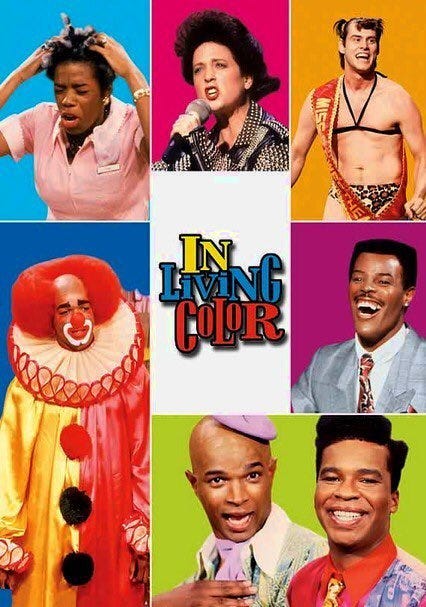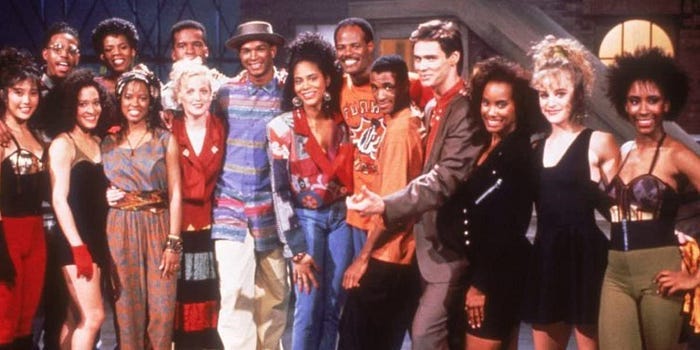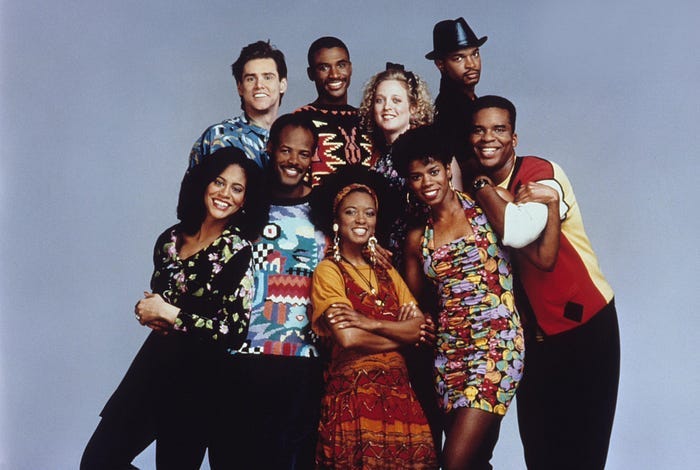Breaking Barriers: The Impact and Legacy of In Living Color in American Comedy
Happy 35th Anniversary, In Living Color
Happy 35th Anniversary, In Living Color
On April 15, 1990, In Living Color boldly premiered on Fox, marking a significant moment in American television history. Created, written, and starring Keenen Ivory Wayans, this groundbreaking sketch comedy series demanded attention. Its title drew inspiration from NBC’s historic broadcasts presented “in living color” during the 1960s. It resonated with the term “person of color,” emphasizing the show’s predominantly African American cast — an essential distinction compared to other popular sketch comedies, such as Saturday Night Live, which relied heavily on White performers.
In Living Color introduced a unique brand of irreverent Black humor, a stark contrast to the safe, family-friendly Black comedy dominating mainstream American tastes at the time, such as The Cosby Show. This distinctive approach sparked a creative control battle between the Wayans family and Fox executives, underscoring the show’s cultural impact.
The pilot episode featured an array of unforgettable sketches that set the tone for the series. Highlights included “Love Connection: Jewish Woman Dates a Black Man,” “Great Moments in Black History: First Black Man on the Moon,” “Homeboy Shopping Network,” “Redd Foxx for Hire,” “Equity Express,” and “Men on Film.” Viewers were introduced to an impressive lineup of cast members, including Jim Carrey, Kelly Coffield, Kim Coles, Tommy Davidson, David Alan Grier, T’Keyah Crystal Keymáh, Damon Wayans, Keenen Ivory Wayans, and Kim Wayans. The episode also showcased the talents of Cari French, Carrie Ann Inaba, Deidre Lang, Lisa Marie Todd, and Michelle Whitney-Morrison as the inaugural Fly Girls. At the same time, Shawn Wayans made a dynamic debut as DJ SW-1. This series played a pivotal role in reshaping the landscape of television comedy.
The show was immensely popular in its first two seasons, capturing a Nielsen rating of more than 10 points. However, in the third and fourth seasons, ratings faltered as the Wayans brothers clashed with Fox network leadership over creative control and rights.
The series won the Primetime Emmy Award for Outstanding Variety, Music or Comedy Series in 1990. The series gained international prominence for its bold move and its all-time high ratings gained by airing a live, special episode as a counterprogram for the halftime show of U.S. leader CBS’s live telecast of Super Bowl XXVI, prompting the National Football League to book A-list acts for future game entertainment, starting with Michael Jackson the following year.
In Living Color’s Cultural Impact
In Living Color had a profound cultural impact during its 1990s run and continues to influence comedy and television today. As one of the first sketch comedy shows to feature a predominantly African American cast, it broke barriers and brought diverse perspectives to mainstream media. The show’s irreverent humor and unfiltered approach challenged stereotypes, sparking conversations about race, identity, and representation in Hollywood.
The series addressed social issues through its sketches, providing a platform for Black voices in a way few shows had previously done. Its memorable characters became cultural touchstones, like the Homey D. Clown and the Fly Girls. The show helped launch the careers of several actors and comedians, including Jim Carrey and Jamie Foxx, who would go on to have successful careers in film and television.
Moreover, In Living Color significantly influenced the format and style of sketch comedy that followed. The show’s dynamic energy and innovative use of music and dance set a precedent for future shows. Its success demonstrated a market for diverse voices in comedy, paving the way for other projects featuring actors and writers from underrepresented backgrounds. This influence on future comedy shows sheds light on the show’s impact on the entertainment industry.
The series was also notable for its willingness to tackle controversial topics, often blending humor with social commentary. This empowered a generation of comedians to address issues surrounding race, gender, and culture, fostering a richer dialogue in the entertainment industry. We can all appreciate the show’s contribution to fostering a richer dialogue in the entertainment industry.
In Living Color significantly reshaped the landscape of television comedy, leaving an enduring mark as a symbol of creativity, boldness, and artistic representation. Its legacy inspires new generations of comedic talent and storytelling, cementing its influence on the industry.
In Living Color’s Legacy
The legacy of In Living Color is profound and enduring, marking a pivotal moment in the evolution of television comedy. Premiering in 1990, the show not only showcased a predominantly African American cast but also challenged conventional norms of humor and representation in an era when such diversity was rare in mainstream media. Its innovative sketches and memorable characters, like the Homey D. Clown and the Fly Girls, left an indelible mark on pop culture, becoming icons in their own right.
In Living Color significantly contributed to the entertainment industry by fearlessly tackling controversial social issues. By blending humor with insightful social commentary, the show opened up avenues for discussions about race, identity, and cultural stereotypes, giving voice to marginalized perspectives that are often overlooked in Hollywood. This fearless approach inspired many comedians and writers to address important topics, fostering a culture of dialogue and awareness in the industry.
The show’s format, dynamic energy, and unique blend of music, dance, and sketch comedy set a new standard for future productions. It paved the way for a wave of shows that followed, highlighting the importance of diversity not just in front of the camera but also behind it. Many actors and comedians, including those who gained fame through In Living Color, have significantly influenced the industry, demonstrating the show’s lasting impact on their careers and comedic styles. The show’s influence on the careers of its actors and comedians is genuinely inspiring.
Additionally, In Living Color broke barriers regarding the commercial viability of programming featuring diverse voices. Its success demonstrated a substantial audience for this type of content, encouraging networks to invest in projects that reflect various experiences and backgrounds.
Overall, In Living Color’s legacy is one of creativity and boldness. It remains a landmark series that reshaped the comedy landscape, leaving an inspirational blueprint for future generations of comedic talent and storytelling. This ensures that the conversation about representation and diversity in media continues.






